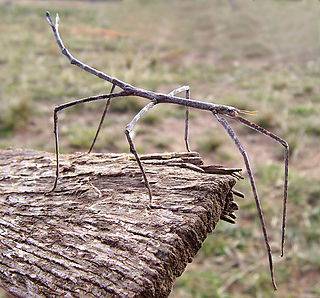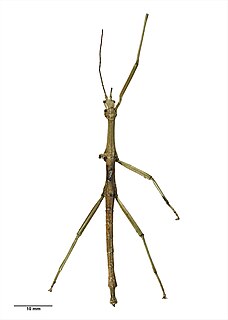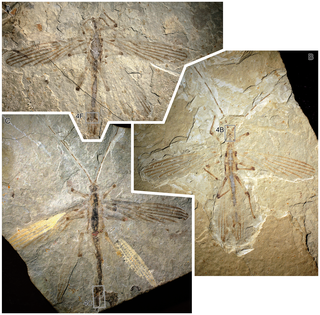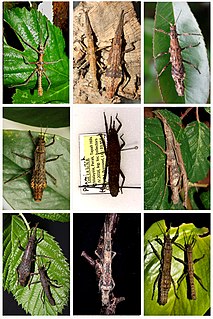
The Phasmatodea are an order of insects whose members are variously known as stick insects, stick-bugs, walking sticks, or bug sticks. They are generally referred to as phasmatodeans, phasmids, or ghost insects. Phasmids in the family Phylliidae are called leaf insects, leaf-bugs, walking leaves, or bug leaves. The group's name is derived from the Ancient Greek φάσμα phasma, meaning an apparition or phantom, referring to their resemblance to vegetation while in fact being animals. Their natural camouflage makes them difficult for predators to detect; still, many species have one of several secondary lines of defence in the form of startle displays, spines or toxic secretions. Stick insects from the genera Phryganistria, Ctenomorpha, and Phobaeticus includes the world's longest insects.

Heteropteryx dilatata is a large species stick insect, in the monotypic genus Heteropteryx and gives its name to the family of the Heteropterygidae. It may be known as the: Jungle nymph, Malaysian stick insect, Malaysian wood nymph, Malayan jungle nymph, or Malayan wood nymph and is commonly kept in zoological institutions and private terrariums of insect lovers. It originates in Malay Archipelago, more precisely on the Malay Peninsula and Borneo and is nocturnal.

Argosarchus is a monotypic genus in the family Phasmatidae containing the single species Argosarchus horridus, or the New Zealand bristly stick insect, a stick insect endemic to New Zealand. The name "horridus" means bristly in Latin, likely referring to its spiny thorax.

The Phasmatinae are a subfamily of stick insects in the family Phasmatidae. They contain at least three tribes; Bradley and Galil corrected the spelling to "Phasmatinae" and provides a key to tribes.

Acanthoxylini is a tribe of Phasmatodeas. They belong to the "typical" stick insects of the superfamily Anareolatae, though they are rather notable among these. For example, the New Zealand giant stick insect is huge, and all Acanthoxyla are females reproducing by parthenogenesis.

Clitarchus hookeri, is a stick insect of the family Phasmatidae, endemic to New Zealand. It is possibly New Zealand's most common stick insect. Clitarchus hookeri is often green in appearance, but can also be brown or red. Alongside the prickly stick insect and the Unarmed stick insect, C. hookeri is one of three stick insect species to have become naturalised in Great Britain, with all three having originated in New Zealand.

Acanthoxyla is a genus of stick insects in the family Phasmatidae. All the individuals of the species are female and reproduce asexually by parthenogenesis. However, a male Acanthoxyla inermis was recently discovered in the UK, probably the result of chromosome loss. The genus is the result of interspecific hybridisation resulting in some triploid lineages and some diploid lineages. The genus is endemic to New Zealand, but some species have been accidentally introduced elsewhere. The genus name Acanthoxyla translates from Greek as prickly stick.

Pseudoclitarchus sentus is the sole representative of the genus Pseudoclitarchus, and is a stick insect endemic to the Three Kings Islands. It lives mainly on kanuka trees.
Clitarchus rakauwhakanekeneke is a stick insect that belongs the common New Zealand genus Clitarchus. It lives only on the Poor Knights Islands.
Clitarchus tepaki is a stick insect that belongs to the common New Zealand genus Clitarchus. It is endemic to the North Cape area of New Zealand, in particular Te Paki and the Karikari Peninsula.
Tepakiphasma ngatikuri is a stick insect of the family Phasmatidae, endemic to a single patch of forest near the northernmost tip of the North Island, New Zealand. It was not discovered until 2008, and is the only member of the genus Tepakiphasma.

Cretophasmomima is an extinct genus of stem-stick insect from the Cretaceous of Eurasia and is one of the oldest and most basal stick insects known. The type species, Cretophasmomima vitimica, was described in 1985 from the Aptian aged Zaza Formation in Russia. A second species, Cretophasmomima burjatica was described from the same formation in 1988. A third and fourth species, Cretophasmomima clara and Cretophasmomima arkagalica were also described in 1988 in the same paper from the Ola Formation and the Arkagalinskaya Formation respectively, both formations are Lower Campanian in age. A fifth species Cretophasmomima melanogramma was described in 2014 off the basis of three specimens from the Aptian Yixian Formation in China. In 2020 a sixth species Cretophasmomima traceyae was described based on a forewing with preserved colouration from the Barremian aged Weald Clay Formation in England.

Spinotectarchus acornutus is a species of stick insect endemic to New Zealand. It belongs to the family Diapheromeridae, and is the only member of the genus Spinotectarchus. It is commonly referred to as the spiny ridge-backed stick insect.

Niveaphasma annulata is a species of stick insect found in New Zealand.

The Obriminae are the most species-rich subfamily of the Phasmatodea family Heteropterygidae native to Southeast Asia. It is divided into two tribe.

Datamini is the only tribe within the subfamily of the Dataminae from the order of the Phasmatodea. The representatives of this subfamily are on average not as large as those of the other two subfamilies belonging to the family of Heteropterygidae.

The genus Hoploclonia is the only one of the tribe Hoplocloniini and brings together relatively small and darkly colored Phasmatodea species.

Aretaon is a genus of stick insects native to Borneo and the Philippine island Palawan.

Brasidas is a genus that is native to the Philippines and is named after the Spartan general Brasidas
















